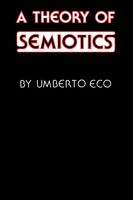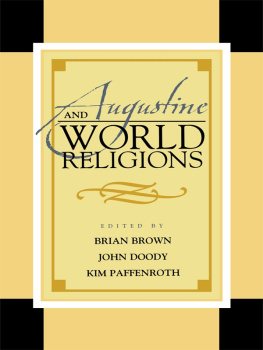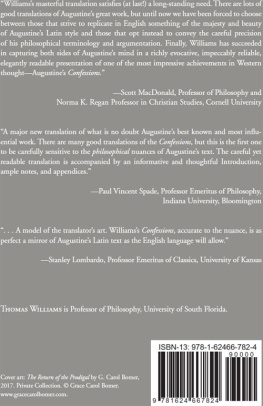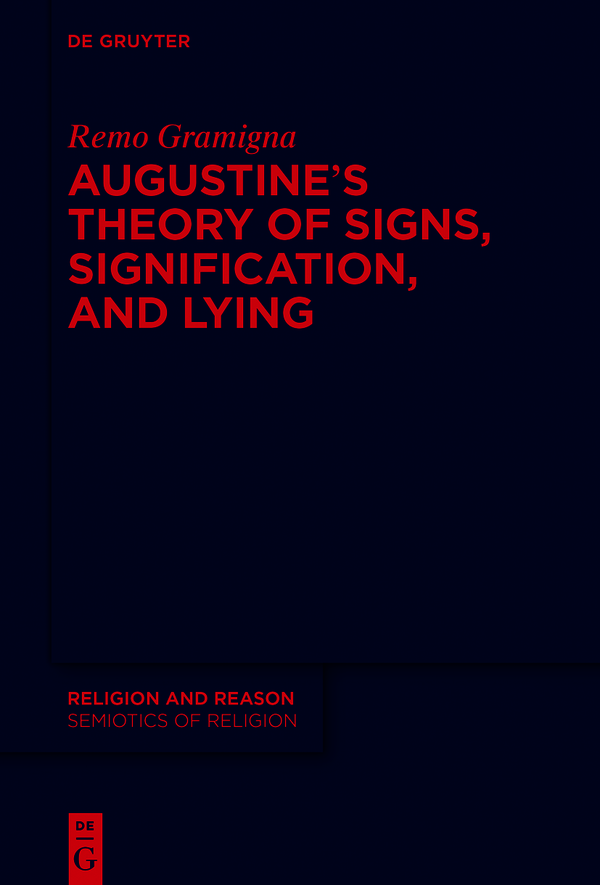Remo Gramigna
Augustine's Theory of Signs, Signification, and Lying
Semiotics of Religion
Edited by
Massimo Leone
Fabio Rambelli
Robert Yelle
Volume
Remo Gramigna
Augustine's Theory of Signs, Signification, and Lying
ISBN 9783110595772
e-ISBN (PDF) 9783110596625
e-ISBN (EPUB) 9783110593709
Bibliographic information published by the Deutsche Nationalbibliothek
The Deutsche Nationalbibliothek lists this publication in the Deutsche Nationalbibliografie; detailed bibliographic data are available on the Internet at http://dnb.dnb.de.
2020 Walter de Gruyter GmbH, Berlin/Boston
To my father, Gerardo Gramigna, because he has been an inspiration to me and has helped me persevere through the many challenges I have had.
Acknowledgments
The present study is the pinnacle of numerous years of continuing interest in the thought of Augustine of Hippo. I wish to register my warm thanks to Dr. Timo Maran, whose unfailing assistance and judicious criticism helped me in preparing this work. I am also indebted to Professors Costantino Marmo and Giovanni Manetti who both provided me with constructive criticisms and insightful feedback. I am thankful to Professor Eugenio DAmico, Franco Tarsitano, Professor Silvana Vecchio and Professor Maria Bettetini, who carefully read some chapters of this work and provided assistance in formulating the general topic of this book. Silvana Vecchio has also read the chapter on lying, giving me constructive feedback. I should like to offer my appreciation to Giovanni Capatano and Angela Longo, for their interest as outside readers of this study and for providing insightful suggestions. To Mr. Jonathan Grant Griffin, Mr. Julian Bates, and Mr. David Bill who all proofread and edited the manuscript, is offered my great appreciation. A special acknowledgment goes to Dr. Silvi Salupere for the inspiration she gave me throughout my university years in Estonia, and to Professor Marina Grishakova for supporting my research at the University of Tartu.
I take this opportunity also of thanking my uncle, Ugo Vetere, whose advice, criticism and teachings he passed on to me during the last years of his life have been invaluable. I am deeply indebted to him and to my family for the untiring support they all provided throughout the long period of writing and research. It would have not been possible to complete this work without their aid. I am dedicating this book to my father, Gerardo Gramigna, because he has been an inspiration to me and has helped me persevere through the many challenges I have had.
This research was supported by the Estonian Research Council (Grant 1481, The Role of Imaginary Narrative Scenarios in Cultural Dynamics) and by the European Regional Development Fund (Center of Excellence in Estonian Studies).
Abbreviations
Abbreviations of Augustines works
beata v.
Beata vita liber unus
conf.
Confessionum librim tredicim
c. mend.
Contra mendacium liber unun
dial.
De dialectica
doctr. chr.
De doctrina christiana libri quattour
f. et symb.
De fide et symbolo liber unus
mend.
De mendacio liber unun
mag.
De magistro
trin.
De trinitate libri quindecim
s. dom. m.
De sermone domini in monte libri duo
vera relig.
De vera religione liber unus
ench.
De fide spe et caritate liber unus
retr.
Retractationum libri duo
s.
Sermones
sol.
Soliloquia
CCL
Corpus christianorum, Series Latina
CSEL
Corpus Scriptorum Ecclesiasticorum Latinorum
PL
Patrologiae cursus completus. Series Latina, ed. J.-P. Migne
Other abbreviations
CP
Collected Papers of Charles S. Peirce
MS
Manuscript
EP
Essential Peirce
List of figures/List of tables
Figure | Page |
| The structure and classifications outlined in the first four chapters of the De dialectica (ch. I-IV) | |
| The semiotic triangle | |
| The dimensions of signification and communication | |
| Signum rei and signum verbi | |
| The twofold character of the sign | |
| The threefold division as outlined in 4,7 and the criteria used for the distinctions | |
| The signification of words | |
| Signs shown by signs | |
| Signs of things and signs of signs | |
| Audible signs | |
| The extension of verbum (word) and nomen (noun) | |
| An outline of the division of signs in the De magistro | |
| The signifying mechanism of speaking | |
14a | The structure of the De doctrina christiana | |
14b | The structure of the De doctrina christiana | |
| The primary meaning of res | |
| The secondary meaning of res | |
| The res/signum division in light of their intransitive/transitive character | |
| False as deceitful and false as fictitious | |
| The res/signum continuum | |
Table | Page |
| Objects and means used in signifying | |
| The threefold divisions as presented in 4,7 and 20: their respective order and differences. | |
| Two scenarios of deception: false speech told not to deceive and truthful speech in order to deceive | |
| Augustines eightfold gradation of lies revisited in light of Aquinass threefold division | |
| An outline of sign conceptions in Augustine | 203204 |
| An outline of sign relations in Augustine | |
| An outline of sign relations in Augustine | |
Introduction
Scope of the investigation
Humankind has crafted and used symbols of all sorts for millennia. It is not surprising that the concern towards the study of the concept of the sign cuts across the entire history of humanity, drawing criticisms and appraisals in a debate that is as fascinating as it is complex. The study of the notion of the sign has deep and ancient philosophical roots, to the extent that it is addressed in many branches of human knowledgefrom Hippocratic medicine to classical rhetoricyielding results often intertwined in a concordant or discordant way. However, it is possible to trace time periods in the history of Western thought in which the subject has been addressed organically and in greater depth.







